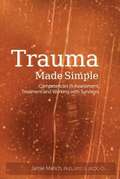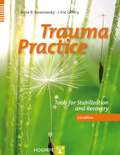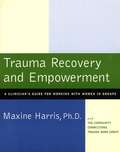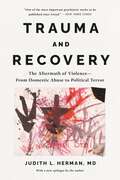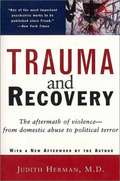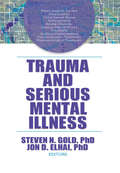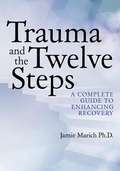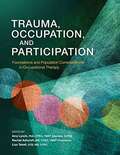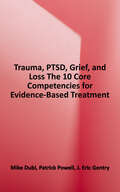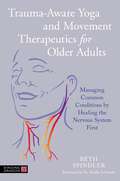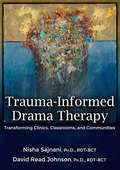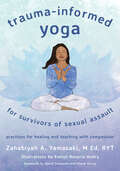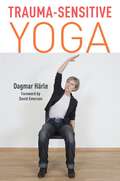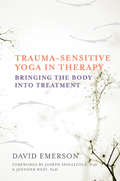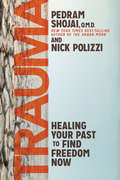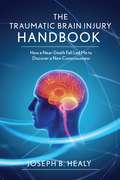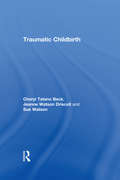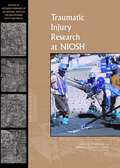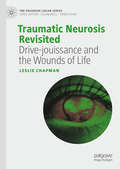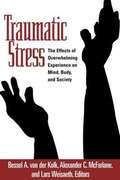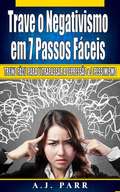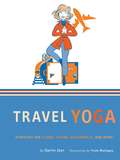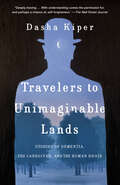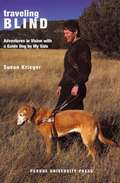- Table View
- List View
Trauma Made Simple: Competencies in Assessment, Treatment and Working with Survivors
by Jamie MarichIn Trauma Made Simple, trauma expert Dr. Jamie Marich brings her practical style of training to print, using clinical common sense to wade through theory, research, and hype surrounding trauma. Learn about trauma in a way that is relevant to clinical work, including extensive coverage on PTSD and other diagnoses through a bio-psycho-social-spiritual lens. Make clinically informed decisions based on setting, client preparedness, and other contextual variables. Develop strategies for treatment planning based on the best possible treatments in the field today. Trauma Made Simple addresses a variety of issues that are imperative to trauma competency in clinical work, including how to handle grief and mourning, assessing for and addressing addiction (even if you are not an addiction counselor) and how to manage professional development issues, including self-care.
Trauma Practice, Third Revised and Expanded Edition: Tools For Stabilization And Recovery
by Anna B. Baranowsky J. Eric Gentry<P>An updated, comprehensive, and essential reference and tool-kit for treating trauma survivors. <P>Filled with new resources, this book based on the tri-phasic trauma treatment model is a guide for both seasoned trauma therapists and newer mental health professionals seeking practical approaches that work.
Trauma Recovery and Empowerment: A Clinician's Guide For Working With Women in Groups
by Maxine HarrisThis one-of-a-kind guide serves as a rich and essential resource for mental health professionals working with women whose lives have been shattered by the trauma of sexual, physical, or emotional abuse. The book presents a practical, step-by-step guide to implementing a group recovery program for female trauma survivors.
Trauma and Recovery: The Aftermath of Violence, from Domestic Abuse to Political Terror
by Judith Lewis HermanWhen Trauma and Recovery was first published in 1992, it was hailed as a groundbreaking work. In the intervening years, it has become the basic text for understanding trauma survivors. By placing individual experience in a broader political frame, Judith Herman argues that psychological trauma can be understood only in a social context. Drawing on her own research on incest, as well as on a vast literature on combat veterans and victims of political terror, she shows surprising parallels between private horrors like child abuse and public horrors like war. A new epilogue reviews what has changed--and what has not changed--over two decades. Trauma and Recovery is essential reading for anyone who seeks to understand how we heal and are healed.
Trauma and Recovery: The Aftermath of Violence--from Domestic Abuse to Political Terror
by Judith Lewis Herman<p>When <i>Trauma and Recovery</i> was first published in 1992, it was hailed as a groundbreaking work. In the intervening years, Herman's volume has changed the way we think about and treat traumatic events and trauma victims. In a new afterword, Herman chronicles the incredible response the book has elicited and explains how the issues surrounding the topic have shifted within the clinical community and the culture at large. <p><i>Trauma and Recovery</i> brings a new level of understanding to a set of problems usually considered individually. Herman draws on her own cutting-edge research in domestic violence as well as on the vast literature of combat veterans and victims of political terror, to show the parallels between private terrors such as rape and public traumas such as terrorism. <p>The book puts individual experience in a broader political frame, arguing that psychological trauma can be understood only in a social context. Meticulously documented and frequently using the victims' own words as well as those from classic literary works and prison diaries, <i>Trauma and Recovery</i> is a powerful work that will continue to profoundly impact our thinking.</p>
Trauma and Serious Mental Illness
by Jon D. Elhai Steven N. GoldAn exploration of the newfound connections between mental illness and trauma For decades, the idea that serious mental illnesses (SMIs) are almost exclusively biologically-based and must be treated pharmacologically has been commonplace in psychology literature. As a result, many mental health professionals have stopped listening to their clients, categorizing their symptoms as manifestations of neurologically-based disturbed thinking. Trauma and Serious Mental Illness is the groundbreaking series of works that challenge this standard view and provides a comprehensive introduction to the emerging perspective of SMIs as trauma-based. This unique collection illustrates how different psychotherapy approaches can lead to reduced symptomatology, decreased psychological distress, and improved functioning in individuals living with SMIs. Each extensively-referenced chapter in Trauma and Serious Mental Illness offers mental health workers a forward-looking theoretical inquiry, empirical study, or critical treatise providing compelling counter evidence to challenge the widespread belief that SMIs are not reactions to the extreme and extremely disturbing circumstances embodied by psychological trauma. In addition to the etiological application, this revealing text proposes ways to incorporate this cutting-edge approach toward treatment options as well. Contributors to Trauma and Serious Mental Illness suggest that: childhood trauma is related to psychotic disorders dissociation can be confounded with psychotic symptoms auditory hallucinations can be diagnostic of dissociation rather than psychosis psychosis is related to the quality of family of origin environment and to age of onset of childhood abuse bipolar and trauma-related disorders sometimes overlap individuals with SMIs suffer related trauma even in treatment facilities and much more!Trauma and Serious Mental Illness is an eye-opening resource for mental health professionals, psychologists, counselors, psychiatrists, social workers, trauma workers, and educators and students in these disciplines.
Trauma and the Twelve Steps: A Complete Guide For Enhancing Recovery
by Jamie MarichGetting this book to press has been a bit of an uphill battle. In preparing this manuscript for publication, I ran into the same struggles that I encounter working as a clinician in the helping professions. Mental health publishers felt that this book was "too addiction." Addiction publishers felt it was "too mental health." Academic publishers called it too "colloquial," and self-help publishers too "academic."
Trauma, Occupation, and Participation: Foundations and Population Considerations in Occupational Therapy
by Amy Lynch Rachel Ashcraft Lisa TekellChildren and adults with complex trauma histories need to feel safe, be able to regulate emotions, develop relationships, and gain mastery over their environment and important occupations. Occupational therapy practitioners are valuable members of the complex trauma treatment team because of their expertise in the cognitive, social, emotional, and sensory components of occupation. This comprehensive text guides occupational therapy practitioners in applying trauma-responsive care with their clients across contexts with evidence-based models of assessment and intervention.
Trauma, PTSD, Grief & Loss: The 10 Core Competencies for Evidence-Based Treatment
by J. Eric Gentry Mike Dubi Patrick PowellTrauma, PTSD, Grief & Loss provides a holistic and systemic path to understanding traumatic stress, and charts the most effective treatments, outlined in the 10 core trauma competencies. Trauma experts J. Eric Gentry and Mike Dubi bring 70+ years of clinical trauma experience, providing best-practice, evidence-based clinical interventions and techniques.Key approaches and interventions include:+ Feedback Informed Therapy+ Self-Regulation+ EMDR+ Tri-Phasic Model+ Exposure Based Therapies+ CBT+ Narrative Exposure Therapy
Trauma-Aware Yoga and Movement Therapeutics for Older Adults: Managing Common Conditions by Healing the Nervous System First
by Beth SpindlerDiscover the yoga and movement therapies at the heart of health in later life through this accessible guide for teachers and therapists.Beth Spindler has devised innovative movement practices based around acknowledging the trauma and vulnerability that come with a lifetime of memories. Trauma can exacerbate the effects of illnesses and conditions common in older adults, including depression, dementia, Parkinson's and arthritis. The movement and yoga therapeutics in this volume take a holistic approach to healing trauma alongside gentle practices to aide in managing symptoms in later life. Each chapter takes on a different condition or situation, explores how they can relate to trauma, and provides both the physical movement and the breathing exercises to address the issue.Complete with illustrations and adaptations for any setting or ability, the practices in this guide are suitable for many practitioners working with either individuals or groups.
Trauma-Informed Drama Therapy: Transforming Clinics, Classrooms, and Communities
by David Read Johnson Nisha SajnaniA collection of thought provoking articles and descriptions of the powerful work that can be and is being done to help heal trauma.
Trauma-Informed Yoga for Survivors of Sexual Assault: Book and Card Deck Set
by Zahabiyah YamasakiTrauma-informed yoga guidance for survivors, instructors, and mental health professionals. Trauma-Informed Yoga for Survivors of Sexual Assault provides a comprehensive overview of how to offer yoga to survivors of sexual assault in a safe, effective, evidence-based, and healing way. Zahabiyah A. Yamasaki, program director of Trauma Informed Programs at UCLA and founder of Transcending Sexual Trauma through Yoga, draws on the framework of trauma-informed care and trauma-informed yoga program development and curriculum, while also weaving in personal narrative and inspiring survivor stories. This book explores practical considerations for survivors, as well as for yoga teachers, mental health professionals, educators, and other healing professionals who are interested in integrating trauma-informed yoga into the scope of their work and/or healing. This book expands the scope and framework for healing and fills a much-needed gap in service delivery for survivors. Yamasaki provides holistic, trauma-informed, body-based, compassionate, and culturally affirming options for survivors as they navigate what is oftentimes a lifelong and nonlinear process of healing.
Trauma-Sensitive Yoga
by David Emerson Christine M. Grimm Dagmar HärleTraumatic events are more than a narrative or singular event in a person's life; the body remembers traumatic events and can experience them over and over, even after many years have passed. This book shows how trauma-sensitive yoga can be used in individual therapy and in groups to overcome trauma, by calming the nervous system and helping people to come out of dissociative states. The book also shows teachers how to detect when certain postures trigger anxiety, and offers ways to support healing in general yoga classes. Drawing on her experience as both trauma therapist and yoga teacher, the author focuses on the body-mind connection and presents asanas and breathing exercises that can help traumatised patients re-engage and take control of their bodies.
Trauma-Sensitive Yoga in Therapy: Bringing the Body into Treatment
by David Emerson Jennifer WestThis practical guide presents the cutting-edge work of the Trauma Center's yoga therapy program, teaching all therapists how to incorporate it into their practices. When treating a client who has suffered from interpersonal trauma--whether chronic childhood abuse or domestic violence, for example--talk therapy isn't always the most effective course. For these individuals, the trauma and its effects are so entrenched, so complex, that reducing their experience to a set of symptoms or suggesting a change in cognitive frame or behavioral pattern ignores a very basic but critical player: the body. In cases of complex trauma, mental health professionals largely agree that the body itself contains and manifests much of the suffering--self hatred, shame, and fear. Take, for example, a woman who experienced years of childhood sexual abuse and, though very successful in her professional life, has periods of not being able to feel her limbs, sensing an overall disconnection from her very physical being. Reorienting clients to their bodies and building their "body sense" can be the very key to unlocking their pain and building a path toward healing. Based on research studies conducted at the renowned Trauma Center in Brookline, Massachusetts, this book presents the successful intervention known as Trauma-Sensitive Yoga (TSY), an evidence-based program for traumatized clients that helps them to reconnect to their bodies in a safe, deliberate way. Synthesized here and presented in a concise, reader-friendly format, all clinicians, regardless of their background or familiarity with yoga, can understand and use these simple techniques as a way to help their clients achieve deeper, more lasting recovery. Unlike traditional, mat-based yoga, TSY can be practiced without one, in a therapist's chair or on a couch. Emphasis is always placed on the internal experience of the client him- or herself, not on achieving the proper form or pleasing the therapist. As Emerson carefully explains, the therapist guides the client to become accustomed to feeling something in the body--feet on the ground or a muscle contracting--in the present moment, choosing what to do about it in real time, and taking effective action. In this way, everything about the practice is optional, safe, and gentle, geared to helping clients to befriend their bodies. With over 30 photographs depicting the suggested yoga forms and a final chapter that presents a portfolio of step-by-step yoga practices to use with your clients, this practical book makes yoga therapy for trauma survivors accessible to all clinicians. As an adjunct to your current treatment approach or a much-needed tool to break through to your traumatized clients, Trauma-Sensitive Yoga in Therapy will empower you and your clients on the path to healing.
Trauma: Healing Your Past to Find Freedom Now
by Pedram Shojai Nick PolizziYou are not doomed to be trapped by your traumaTrauma is unresolved pain. It hums in the background of our lives and robs us of the joy, faith, peace, and love we fully deserve. In their groundbreaking book, Pedram Shojai, O.M.D., New York Times best-selling author of The Urban Monk and The Art of Stopping Time, and Nick Polizzi, author of The Sacred Science, take you on a journey that encompasses: • a clear understanding of trauma, where it comes from, and how it affects every part of your life • an exploration of modern and ancient therapies and practices for healing • real-life tragedies turning into stories of triumph, hope, and survival Drawn from the wisdom and insights of the world's top doctors, therapists, and experts, Trauma will show you that no matter what you have endured, how long you have carried it, or how deeply embedded it is, you can be free from pain and suffering. Your road to recovery and whole-body healing is before you, and with it the richer and more profound connections that you seek with yourself and your loved ones.
Traumatic Brain Injury Handbook: How a Near-Death Fall Led Me to Discover a New Consciousness
by Joseph HealyNew Consciousness is the ultimate brain injury recovery handbook. Inside, acclaimed writer Joe Healy comprehensively discusses what leads to brain injuries and how to heal from them and manage them during the process. Recovery techniques are lifestyle modifications: nutritional, physical, occupational, and attitude ones. This is an important title for all family and friends of sufferers of brain injuries, doctors, and caretakers. With Healy's guidance, support networks will learn how to lead sufferers on their journey back to "normalcy," working and socializing as the person did before the traumatic event. This unique book is distinctive in its scope, covering the science of the brain, its easy-to-follow nature, its accuracy, and its encouraging you-can-recover, don't just learn to cope and give up attitude. Family, friends of the injured person no longer need to feel alone, discouraged, or overwhelmed. This is a much-needed, hands-on, and extremely valuable volume.
Traumatic Childbirth
by Jeanne Watson Driscoll Cheryl Tatano Beck Sue WatsonPostpartum depression has become a more recognized mental illness over the past decade as a result of education and increased awareness. Traumatic childbirth, however, is still often overlooked, resulting in a scarcity of information for health professionals. This is in spite of up to 34% of new mothers reporting experiencing a traumatic childbirth and prevalence rates rising for high risk mothers, such as those who experience stillbirth or who had very low birth weight infants. This ground-breaking book brings together an academic, a clinician and a birth trauma activist. Each chapter discusses current research, women’s stories, the common themes in the stories and the implications of these for practice, clinical case studies and a clinician’s insights and recommendations for care. Topics covered include: mothers’ perspectives, fathers’ perspectives, the impact on breastfeeding, the impact on subsequent births, PTSD after childbirth and EMDR treatment for PTSD. This book is a valuable resource for health professionals who come into contact with new mothers, providing the most current and accurate information on traumatic childbirth. It also presents mothers’ experiences in a manner that is accessible to women, their partners, and families.
Traumatic Injury Research at NIOSH: Reviews of Research Programs of the National Institute for Occupational Safety and Health
by Institute of Medicine National Research Council of the National AcademiesThe occurrences of both injury and death that take place on the job are a significant public health problem in the United States, causing a substantial human and economic burden. Traumatic Injury Research at NIOSH is the sixth report in the series Reviews of Research Programs of the National Institute for Occupational Safety and Health. The Committee to Evaluate the NIOSH Traumatic Injury Research Program found the program’s research during 1996-2005 (the evaluation period for this review) relevant to reducing the burden of traumatic injury in the workplace and to have contributed to improvements in worker health and safety. To continue to reduce injuries and deaths to workers due to trauma, the committee recommended that the TI Research Program continue setting goals within the program’s scope and resources; work with other federal agencies that support injury prevention and control research to outline areas of collaboration; embark on a program to increase the visibility of traumatic injury research; develop a strategic plan for evaluating its research-to-practice efforts and for building the capacity to carry out these efforts; and consider research on the safety impacts of changes in the nature of work as well as intervention research targeting organization policies and practices.
Traumatic Neurosis Revisited: Drive-jouissance and the Wounds of Life (The Palgrave Lacan Series)
by Leslie ChapmanThis book argues that Freud&’s theory of the traumatic neuroses can provide a &‘conceptual bridge&’ between the Lacanian idea of an &‘inaugural&’ or &‘founding&’ trauma that constitutes the human subject and the more popular idea that trauma is brought about by external events, for example, war or sexual violence. It proposes a new reading of Freud&’s theory which draws on Lacanian concepts, including the Real, jouissance, the idea of &‘suture&’, and Lacan&’s &‘deconstruction&’ of Freud&’s drive theory. It also argues for a &‘cybernetic&’ reading of Lacan&’s theory of language, which he outlined in his second Seminar; and for a reappraisal of Freud&’s concept of Nachträglichkeit as a way to facilitate a better understanding of the retroactive nature of trauma and its relation to language and the drive. In doing so, it offers a challenge to key assumptions underpinning the dominant discourse of trauma, which is exemplified in what the author terms &‘the PTSD paradigm&’. In particular it challenges the idea that trauma is something that simply &‘happens&’ to human beings and that its effects that can be eradicated through the construction of various forms of trauma narrative, for example, in psychotherapy and different types of collective histories. In the development of this argument the author also draws on the work of Jean Laplanche, which has previously been under-utilised in mainstream Lacanian theory and practice. This book sheds new light on the relationship between the traumatic effects of the signifier and the impact of the &‘external&’ world. It will be of interest to practitioners, as well as to students and scholars of psychoanalysis and philosophy.
Traumatic Stress: The Effects of Overwhelming Experience on Mind, Body, and Society
by Bessel van der Kolk Alexander McfarlaneThis bestselling classic presents seminal theory and research on posttraumatic stress disorder (PTSD). Together, the leading editors and contributors comprehensively examine how trauma affects an individual's biology, conceptions of the world, and psychological functioning. Key topics include why certain people cope successfully with traumatic experiences while others do not, the neurobiological processes underlying PTSD symptomatology, enduring questions surrounding traumatic memories and dissociation, and the core components of effective interventions. A highly influential work that laid the foundation for many of the field's continuing advances, this volume remains an immensely informative and thought-provoking clinical reference and text.
Trave o Negativismo em 7 Passos Fáceis: Treino fácil para ultrapassar a depressão & o pessimismo
by A. J. ParrTRAVE O NEGATIVISMO EM 7 PASSOS FÁCEIS: TREINO FÁCIL PARA ULTRAPASSAR A DEPRESSÃO & O PESSIMISMO (Compreendendo Eckhart Tolle, Dalai Lama, Krishnamurti, Ramana Maharshi e outros!) ESTES EXERCÍCIOS E LIÇÕES CRUCIAIS irão ajudá-lo a quebrar com o hábito dos pensamentos negativos e começar a vivenciar a alegria de Viver, com os ensinamentos dos Mestres do Iluminismo: Eckhart Tolle, Dalai Lama, Krishnamurti, Ramana Maharshi e outros! Os cientistas estimam que em condições normais o ser humano tenha regularmente uma média de 30.000 a 40.000 pensamentos por dia. E, de acordo com as investigações, a depressão é sempre precedida por pensamentos negativos repetitivos e não o oposto, e reduzir o número de pensamentos negativos diários na realidade reduz tanto a frequência como a intensidade dos sentimentos e emoções depressivas! Estas descobertas cruciais constituem o ponto de partida das 7 lições e dos 7 exercícios contidos neste manual para principiantes, concebido para o ajudar a ultrapassar o hábito dos pensamentos negativos, Agora! LIÇÃO 1: O VALOR DA ADVERSIDADE Exercício: Travar os Nossos Pensamentos LIÇÃO 2: SOMOS O QUE PENSAMOS Exercício: Observar os Nossos Pensamentos LIÇÃO 3: A VOZ DO SUBCONSCIENTE Exercício: Meditação da Respiração LIÇÃO 4: PENSAMENTOS NEGATIVOS REPETITIVOS Exercício: Sentir o Corpo Interior LIÇÃO 5: ENCURRALADO NO PASSADO E NO FUTURO Exercício: O Intervalo Sem Tempo LIÇÃO 6: NEGATIVISMO E RESISTÊNCIA Exercício: Render-se ao Agora LIÇÃO 7: VIVENCIAR A ALEGRIA DE VIVER Exercício: Ultrapassar os Pensamentos Negativos . Do que está à espera? Tire uns minutos e leia este manual breve e acessível e comece a sua transformação ainda hoje!
Travel Yoga
by Frank Montagna Darrin ZeerEase the aches, ease the pains, and ease on down the road. From the creator of the best-selling Office Yoga comes the ultimate guide for harried travelers and commuters. Taking the age-old practice of yoga and adapting it for our modern lives, author Darrin Zeer has compiled more than 50 techniques to help travelers relieve muscle tension, master the art of waiting, create hotel room harmony, blow off steam, and arrive revived. The removable guide in back is especially useful for frequent fliers, outlining stretches perfectly suited for small spaces. Packed with playful illustrations by Frank Montagna, Travel Yoga offers a host of techniques guaranteed to soften any landing.
Travel in Adverse Weather Conditions
by Richard L. Welsh William WienerThis report marks the first attempt to pull together the knowledge of a large number of people related to the problem of travel in adverse weather for people who have visual impairments. These ideas represent the state of the art as defined by a wide sample of practitioners from all over the United States who participated in the National Conference on Travel in Adverse Weather in Minneapolis in February, 1975.
Travelers to Unimaginable Lands: Stories of Dementia, the Caregiver, and the Human Brain
by Dasha KiperThese &“moving and often surprising&” (The Wall Street Journal) case histories meld science and storytelling to show that caregivers don&’t just witness cognitive decline in their loved ones with dementia—they are its invisible victims. &“This book will forever change the way we see people with dementia disorders—and the people who care for them.&”—Lori Gottlieb, author of Maybe You Should Talk to Someone A BBC BOOK OF THE WEEK • A TELEGRAPH BEST BOOK OF SUMMERInspired by Dasha Kiper&’s experience as a caregiver and counselor and informed by a breadth of cognitive and neurological research, Travelers to Unimaginable Lands dispels the myth of the perfect caregiver. In these compassionate, nonjudgmental stories of parents and children, husbands and wives, contending with dementia disorders, Kiper explores the existential dilemmas created by this disease: a man believes his wife is an impostor; a woman&’s imaginary friendships with famous authors drive a wedge between her and her devoted husband; another woman&’s childhood trauma emerges to torment her son; a man&’s sudden, intense Catholic piety provokes his wife. Kiper explains why the caregivers are maddened by these behaviors, mirroring their patients&’ irrationality, even though they&’ve been told it&’s the disease at work. By demystifying the neurological obstacles to caregiving, Kiper illuminates the terrible pressure dementia disorders exert on our closest relationships, offering caregivers the perspective they need to be gentler with themselves.
Traveling Blind: Adventures in Vision with a Guide Dog by My Side
by Susan KriegerKrieger (feminist studies, Stanford U.) recounts her experiences as a newly blind person learning to navigate with her guide dog.
